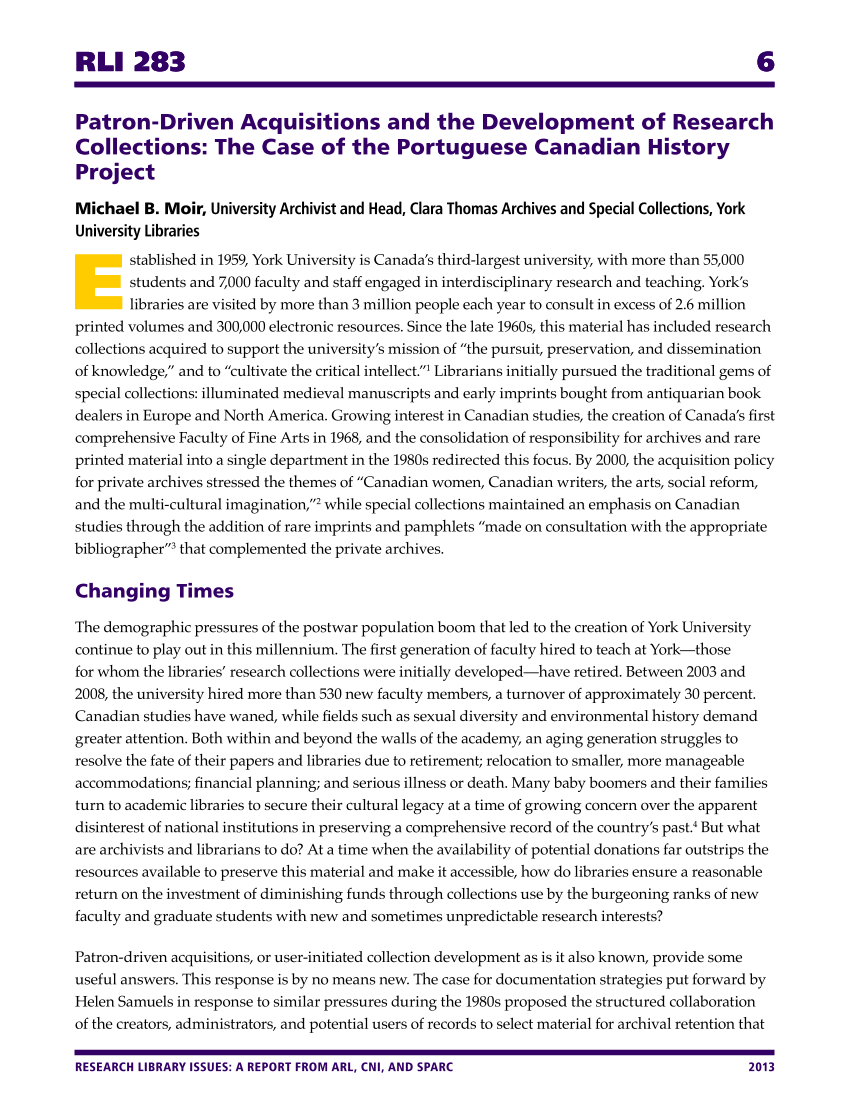RLI 283 6 RESEARCH LIBRARY ISSUES: A REPORT FROM ARL, CNI, AND SPARC 2013 Patron-Driven Acquisitions and the Development of Research Collections: The Case of the Portuguese Canadian History Project Michael B. Moir, University Archivist and Head, Clara Thomas Archives and Special Collections, York University Libraries E stablished in 1959, York University is Canada’s third-largest university, with more than 55,000 students and 7,000 faculty and staff engaged in interdisciplinary research and teaching. York’s libraries are visited by more than 3 million people each year to consult in excess of 2.6 million printed volumes and 300,000 electronic resources. Since the late 1960s, this material has included research collections acquired to support the university’s mission of “the pursuit, preservation, and dissemination of knowledge,” and to “cultivate the critical intellect.”1 Librarians initially pursued the traditional gems of special collections: illuminated medieval manuscripts and early imprints bought from antiquarian book dealers in Europe and North America. Growing interest in Canadian studies, the creation of Canada’s first comprehensive Faculty of Fine Arts in 1968, and the consolidation of responsibility for archives and rare printed material into a single department in the 1980s redirected this focus. By 2000, the acquisition policy for private archives stressed the themes of “Canadian women, Canadian writers, the arts, social reform, and the multi-cultural imagination,”2 while special collections maintained an emphasis on Canadian studies through the addition of rare imprints and pamphlets “made on consultation with the appropriate bibliographer”3 that complemented the private archives. Changing Times The demographic pressures of the postwar population boom that led to the creation of York University continue to play out in this millennium. The first generation of faculty hired to teach at York—those for whom the libraries’ research collections were initially developed—have retired. Between 2003 and 2008, the university hired more than 530 new faculty members, a turnover of approximately 30 percent. Canadian studies have waned, while fields such as sexual diversity and environmental history demand greater attention. Both within and beyond the walls of the academy, an aging generation struggles to resolve the fate of their papers and libraries due to retirement relocation to smaller, more manageable accommodations financial planning and serious illness or death. Many baby boomers and their families turn to academic libraries to secure their cultural legacy at a time of growing concern over the apparent disinterest of national institutions in preserving a comprehensive record of the country’s past.4 But what are archivists and librarians to do? At a time when the availability of potential donations far outstrips the resources available to preserve this material and make it accessible, how do libraries ensure a reasonable return on the investment of diminishing funds through collections use by the burgeoning ranks of new faculty and graduate students with new and sometimes unpredictable research interests? Patron-driven acquisitions, or user-initiated collection development as is it also known, provide some useful answers. This response is by no means new. The case for documentation strategies put forward by Helen Samuels in response to similar pressures during the 1980s proposed the structured collaboration of the creators, administrators, and potential users of records to select material for archival retention that




































